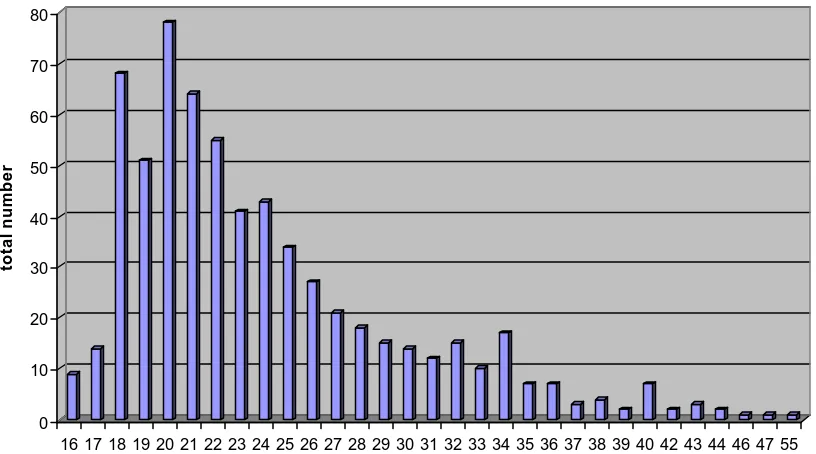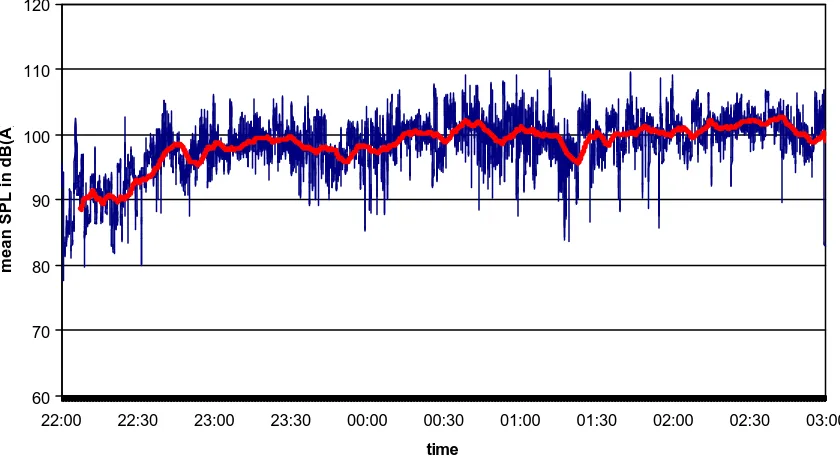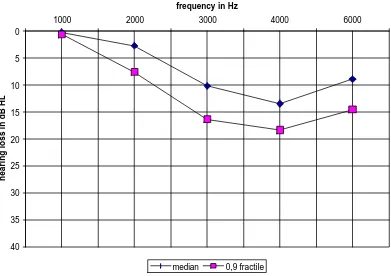NOISE LEVELS IN DISCOTHEQUES
AN ESTIMATION OF THE RISK OF HEARING IMPAIRMENT
PACS: 43.50.Qp
Leitmann, Thilo
Institute of Technical Acoustics, Technical University of Berlin Einsteinufer 25
D-10587 Berlin Germany
Tel: ++49 +30 314-25003 Fax: ++49 +30 314-25135
E-mail: Thilo.Leitmann@TU-Berlin.de
ABSTRACT
There is a growing number of teenagers who suffer from hearing impairments and tinnitus symptoms in Germany. Because of the young age of the examined, leisure noise seems to be responsible for these effects. Visiting discotheques and clubs is one of the most popular spare-time activities of youths.
In a survey carried out in discotheques, the visitors were asked about their visiting habits. In addition, the sound pressure level was measured. The risk of sustaining hearing impairment was calculated due to various noise levels and the duration of exposure in accordance with international standard ISO 1999.
INTRODUCTION
There is a growing number of teenagers who suffer from hearing impairments and tinnitus symptoms in Germany. Because of the young age of the examined, it seems probable that they had no substantial contact to noise at work. Therefore, leisure noise - e.g. high level music, but also impulsive noise of fireworks or toy guns - appears to be responsible for a considerable part of these hearing impairments. The consumption of music plays an important role in the development of teenagers and young adults. Discotheques and concert events are a substantial part of leisure culture and are regularly visited by the majority of young people. Thus, high amplified music in discotheques has been considered as a potential danger to hearing.
The number of incurable hearing impairments, especially with people of young age, is increasing in a troublesome manner. Therefore, the Commission „Sociacusis (hearing loss due to non-occupational noise exposures)“ of the Federal Environmental Agency of Germany recently (2/2000) called for a limitation of the sound pressure levels at clubs and discotheques [1]. The Federal Association of German discotheques (BDT/DEHOGA) announced its support in the fight against leisure noise with potential risk for permanent hearing loss.
RISK OF HEARING IMPAIRMENT IN DISCOTHEQUES
of noise induced hearing loss rises simultaneously. The risk of hearing impairment for the mostly young visitors of discotheques will be estimated on the basis of these parameters. In cooperation with the BDT/DEHOGA, the typical exposure conditions of young visitors were examined in discotheques using questionnaires. The nationwide study especially concentrated on those visitors who spend a relatively longer time on the dance floor, since they are exposed to the highest sound pressure levels. With this approach, this study differs from comparable studies which attempt to formulate findings about a representative cross-section of all youths. Parallel to the quantitative interviews, noise levels were recorded at discotheques. On the basis of the reported time spent on the dance floor and the measured noise levels, an estimation for the potential risks of “noise-induced permanent threshold shift” (NIPTS) according to the international standard ISO 1999.
[image:2.596.87.495.345.572.2]With the permission of the management, the study was conducted in 15 discotheques of the Federal Republic. In choosing the clubs, special attention was paid to the attempt to cover a wide range of different popular music styles. When leavi ng the dance floor, the visitors were approached by the interviewers and asked to fill out a questionnaire relating to their visiting habits and their opinion of the music. In total, 649 visitors aged 16-55 participated as interviewees (Fig. 1). Of those, 55% were men (N = 356), 45 % were women (N = 293). The average participant was 24 years old, the median was 22 years. According to the relevant literature, teenagers start going to clubs between the age of 14 and 16. [3]. After the age of 20, the average frequency of visits decreases again[4]. As a consequence, a period of ten years of regular club visits seems justified.
Fig. 1: Age distribution of the Interviewees
The time spent on the dance floor per week is calculated by the frequency of visits and the time spend on the dance floor per single visit. The median of the time spent on the dance floor weekly is two hours. Concerning the visiting habits of the teenagers, no significant difference between the various types of music played at the clubs could be found. However, the time spent on the dance floor per week may differ sharply from the median for individual interviewees. Therefore, it is paramount with regards to the calculation of risks to pay special attention to those visitors who run a higher risk of hearing impairment due to their visiting habits. About ten per cent of the interviewees claimed to have spent seven or more hours per week on the dance floor of a discotheque. Hence, for the ten-year duration of exposure to noise, a weekly time of seven hours spent on the dance floor is assumed. Measurements of the noise levels on the dance floors resulted in mean sound pressure levels between 96,8 dB(A) and 106,1 dB(A). See figure 2.
0 10 20 30 40 50 60 70 80
total number
16 17 18 19 20 21 22 23 24 25 26 27 28 29 30 31 32 33 34 35 36 37 38 39 40 42 43 44 46 47 55
0 5 10 15 20 25 30 35
%
96-97 98-99 100-101 102-103 104-105 106-107
[image:3.596.116.427.81.263.2]mean sound pressure level in dB(A)
Fig.2: Distribution of mean sound pressure levels in different discotheques
Considering the time profile of the measured noise levels, a light increase of approx. 2 dB per hour can be recognized (Fig. 3). The increasing consumption of alcohol, a more frolicsome atmosphere, but also the compensation of a beginning temporary threshold shift are probably responsible for this effect.
Fig.3: Time profile of the mean SPL on the dance floor of a typical Pop discotheque
Techno or Rock/Alternative clubs often showed results of 105 dB(A) or more. The mean sound pressure levels recorded at Dancefloor or Mainstream discotheques were around 99 dB(A). The Swiss Noise and Laser Ordinance for music events prescribes a limitation of the mean sound pressure level at 93 dB(A) on the dance floor. The expected hearing loss was exemplarily calculated for these three noise levels.
In addition, the expected hearing loss was calculated for individuals with an average sensitivity to noise (0.5 fractile) and for those ten percent of statistical distribution of the visitors who – due to a higher sensitivity – are threatened with heavier hearing loss.
60 70 80 90 100 110 120
22:00 22:30 23:00 23:30 00:00 00:30 01:00 01:30 02:00 02:30 03:00
time
[image:3.596.83.503.392.621.2]The estimated hearing loss is characterized by the typical dip in the frequency range between 3 kHz and 6 kHz. The most severe hearing loss occurs with the exposure of broadband sounds like music at the test frequency of 4000 Hz (Fig. 4, Tab. 1).
0
5
10
15
20
25
30
35
40
1000 2000 3000 4000 6000
frequency in Hz
hearing loss in dB HL
[image:4.596.99.490.139.415.2]median 0,9 fractile
Fig. 4: Estimated hearing loss at a mean SPL of 99 dB(A) and a weekly exposure of 7 hours over a period of ten years
Tab. 1: Estimated hearing loss at a mean SPL of 99 dB(A) and a weekly exposure of 7 hours over a period of ten years
Rote Werte bitte eintragen! in comply with Database A, male
mean SPL in dB(A) weekly exposure in hours exposure time in years Alter
99 7 10 18
frequency in Hz median 0,9 fractile
1000 0,3 0,6 0,7
2000 2,7 7,6 8,8
3000 10,2 16,3 20,5
4000 13,5 18,3 21,5
6000 9,0 14,6 17,4
estimated permanent threshold shift due to noise exposure
The expected hearing loss at this frequency is shown in relation to the weekly time of exposure in Tab. 2 and Tab. 3.
Tab. 2: Comparison of the estimated hearing loss due to different mean SPLs and a weekly exposure of 2 hours over a period of ten years
Tab. 3: Comparison of the estimated hearing loss due to different mean SPLs and a weekly exposure of 7 hours over a period of ten years
If the mean SPL is at 99 dB(A), the expected hearing losses are at a moderate level under 10 dB HL. A level of 93 dB(A) on the dance floor in combination with an average visiting pattern will at most cause a minimal hearing loss. This mean SPL – like every lower noise level – provides a nearly complete protection from hearing impairment through music.
If one considers the hearing loss regarding the three different mean SPLs, it becomes obvious that - on the basis of the visiting habits – the estimated hearing loss reaches high values at the noise level of 105 dB(A).
At such a noise level and with an exposure time of seven hours per week, sensitive individuals already experience a hearing loss which marks the transition from a normally hearing person to someone who is lightly hearing impaired. In Germany, this relatively high level was determined by the Trade Cooperative Association, thus marking the limitations of eligibility for compensation.
The median of those individuals who spend more than seven hours weekly on dance floors with a mean SPL of 99 dB(A) is estimated to show a hearing loss of 13,5 dB HL with a test frequency of 4000 Hz. For 90% of these individuals, a maximum hearing loss of 18,3 dB HL is to be expected. It follows that even especially sensitive individuals with an extreme visiting pattern will not experience a hearing loss more severe than 20 dB HL. Every hearing loss lighter than this mark of 20 dB HL is – even in the stricter sense of preventive diagnostics – considered otologically normal hearing.
Is it possible to empirically prove the calculated hearing loss due to music? A larger number of scientific studies examined the hearing capacity of young adults and analysed the observed hearing impairments. Furthermore, the exposure to noise in the spare-time and working environment was investigated in by means of questionnaires. Comparisons between expected and empirically proven hearing loss show that the effect of loud music on the hearing capacity of young adults is often rather overrated.
mean SPL on the dancefloor
median 0,5 fractile
risk group 0,9 fractile
105 dB(A) 14,4 19,6
99 dB(A) 6,0 8,2
93 dB(A) 1,2 1,7
Estimated permanent threshold shift at 4000 Hz in dB HL for duration of exposure of 2 h a week
mean SPL on the dancefloor
median 0,5 fractile
risk group 0,9 fractile
105 dB(A) 25,2 34,2
99 dB(A) 13,5 18,3
93 dB(A) 5,4 7,4
ACCEPTANCE OF NOISE LEVEL REDUCTIONS IN DISCOTHEQUES
In this study, the assessment of the dance floor noise levels is presented in no direct statistical correlation with the objectively existing noise levels. Nevertheless, there is a significant connection between the subjective judgement of the loudness and one’s attitude towards the discotheque. Therefore, the assessment of the loudness seems to depend less on the existing noise levels, but rather on one’s personal attitude towards the club. A substantial factor in the assessment of the discotheque is – according to the results presented in this study – the kind of music played there. Thus, the largest proportion (approx. 70 %) of the interviewees reported that the type of music played at the club is very important.
In addition, a plethora of other factors could certainly influence the attractiveness of a discotheque to a young visitor which need to be seen in the context of group behaviour, the consumption of alcohol, dating patterns etc. If the visitors are very fond of the discotheque interviewed at, this seems likely to lead to a very uncritical assessment of loudness and sound quality. The results of this analysis can be interpreted in the following way: At most, a reduction of the mean sound pressure level to 99 dB(A) will have a marginal effect on the attitude towards the discotheque. Hence, a reduction in the noise level is unlikely to have considerable impact on the visiting habits of adolescents.
Still, the acceptance of noise level reduction can and must early on be promoted by intensified information efforts aiming at adolescents. In doing so, the risks of exaggerated music consumption and the effects of hearing handicaps must be communicated. The need for such action is highlighted by the fact that of the 649 interviewees in this study, 60 % had never thought about the possible damage risk to hearing and were therefore unaware of such danger.
SUMMARY AND CONCLUDING REMARKS
On the basis of the findings of this study on the visiting habits of visitors of discotheques, a reduction of the mean sound pressure level to 99 dB(A) seems to rule out severe hearing damage. Given one weekly visit to a discotheque over a period of ten years, a light hearing loss of 6 dB HL maximum has to be expected for the largest proportion of the young adults. Even visitors with an extreme visiting habit and a high sensitivity to noise show a hearing loss of less than 20 dB HL at the test frequency at which the sensitivity of the inner ear is highest.
Nevertheless, starting at a mean SPL of 95 dB(A), the promoter of a club should inform his visitors of the noise levels to be expected in an appropriate fashion. In this respect, one might think of a corresponding, clearly visible warning sign in the entrance area. Moreover, the management should provide ear plugs for visitors starting from a constant noise level of more than 95 dB(A). Thus, visitors would be given the opportunity to protect themselves against possible hearing damage. Finally, all the available technical possibilities to reduce the risk of hearing damage should be exhausted.
BIBLIOGRAPHICAL REFERENCES
[1] 12. Sitzung der Kommission „Soziakusis (Zivilisations-Gehörschäden)“ des Umweltbundesamtes (2000): Pegelbegrenzung zum Schutz vor Gehörschäden
[2] Leitmann, T. (2001): Wie bewerten Jugendliche die Lautstärke in Diskotheken? Diskussion eines Richtwertes zur Reduzierung der Schallbelastung im Kontext einer psychoakustisch determinierten Untersuchung der Akzeptanz, TU-Berlin
[3] Hoffmann, E. (1997): Hörfähigkeit und Hörschäden junger Erwachsener. Median-Verlag, Heidelberg


